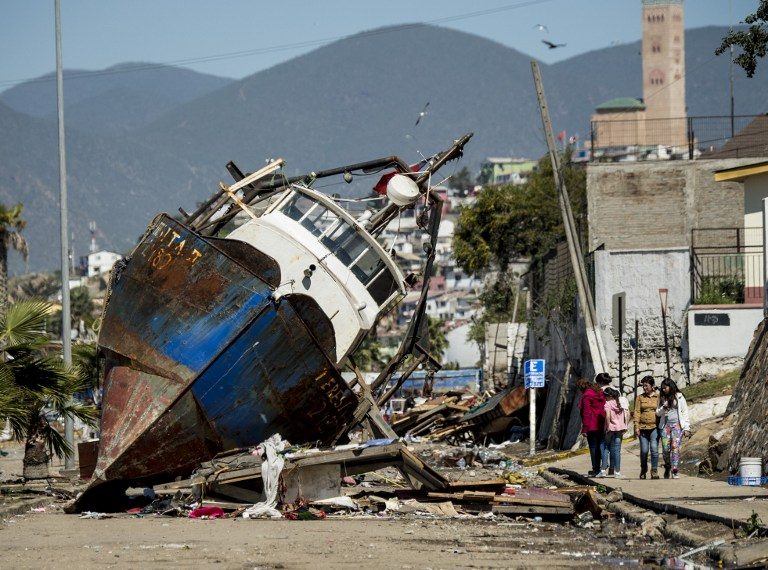SUMMARY
This is AI generated summarization, which may have errors. For context, always refer to the full article.

COQUIMBO, Chile (2nd UPDATE) – Hundreds of traumatized Chileans spent a second night out in the open or in shelters Thursday night, September 17 after an offshore 8.3 magnitude earthquake left 12 dead.
In the coastal city of Coquimbo, the wrath of the earth’s twitch in this quake-prone country was clear and ugly: a jumble of fishing boats, remains of homes, trucks, vendors’ stands and cars washed up by tsunami waves bore testament to the sea’s fury.
Maria Zamorano, 60, recounted how she and her large family ran from the shoreline to save themselves from the surging waves.
“If we had stayed here we would have perished,” she told Agence France-Presse (AFP), as people slowly and warily returned to see what was left of their homes. The town is 400 km north of the capital Santiago.
The earthquake Wednesday evening, September 16 was the 6th strongest in the history of Chile and the most powerful anywhere in the world this year, officials said.
Close to one million people were evacuated from Pacific coastal areas as a precaution as Chile sounded a tsunami alert, with warnings issued as far away as Japan and New Zealand.
But as of Thursday, most of the evacuated Chileans had returned home.
Still, Interior Minister Jorge Burgos said that some 600 people remained in shelters or elsewhere and that some 650 homes were damaged, mainly in Cocquimbo.
The quake occurred at a shallow depth and the epicenter was 228 kilometers (about 140 miles) north of the capital Santiago, a city of 6.6 million people, where there were scenes of pandemonium as thousands fled swaying buildings.
In the hours that followed, tsunami waves of up to 4.5 meters (15 feet) came crashing onshore in the Coquimbo region, causing extensive damage to the region’s port. Eight of the 12 victims were in Coquimbo.
Scenes of destruction also littered the badly hit coastal town of Illapel, further south.
“It was a nightmare,” Maria Ramirez told AFP as she swept up debris outside her house.
“We felt the tremors for a long time, too long. And then all the aftershocks – it was terrible.
“I couldn’t stay standing, but luckily we made it out alive.”
Ring of fire
President Michelle Bachelet headed to the quake-hit area to assess the relief efforts and Secretary of State John Kerry said the United States was ready to help.
Hundreds of homes were declared uninhabitable or destroyed, as authorities tot up the human, emotional and financial cost.
Chile lies on what is known as the “Ring of Fire” – an arc of fault lines that circles the Pacific Basin and is prone to frequent earthquakes and volcanic eruptions.
In February 2010, an 8.8-magnitude quake off the southern Chilean coast killed more than 500 people and inflicted an estimated $30 billion in damage.
The Hawaii-based Pacific Tsunami Warning Center had warned that tsunami waves were possible this time in French Polynesia, Hawaii and California, as well as smaller waves as far afield as Japan and New Zealand.
A minor tsunami was monitored in northern Japan early Friday, September 18 authorities there said.
In Illapel, a town of 30,000, daybreak revealed the damage done, with power knocked out, shacks destroyed, store shelves overturned and the local cemetery a chaos of broken crosses, vases and coffins.
“It was the most horrific moment, a terrible thing,” local resident Ana Cortes, 35, told AFP. “Everything just kept moving, for the longest time.” – Giovanna Fleitas, AFP/Rappler.com
Add a comment
How does this make you feel?
There are no comments yet. Add your comment to start the conversation.